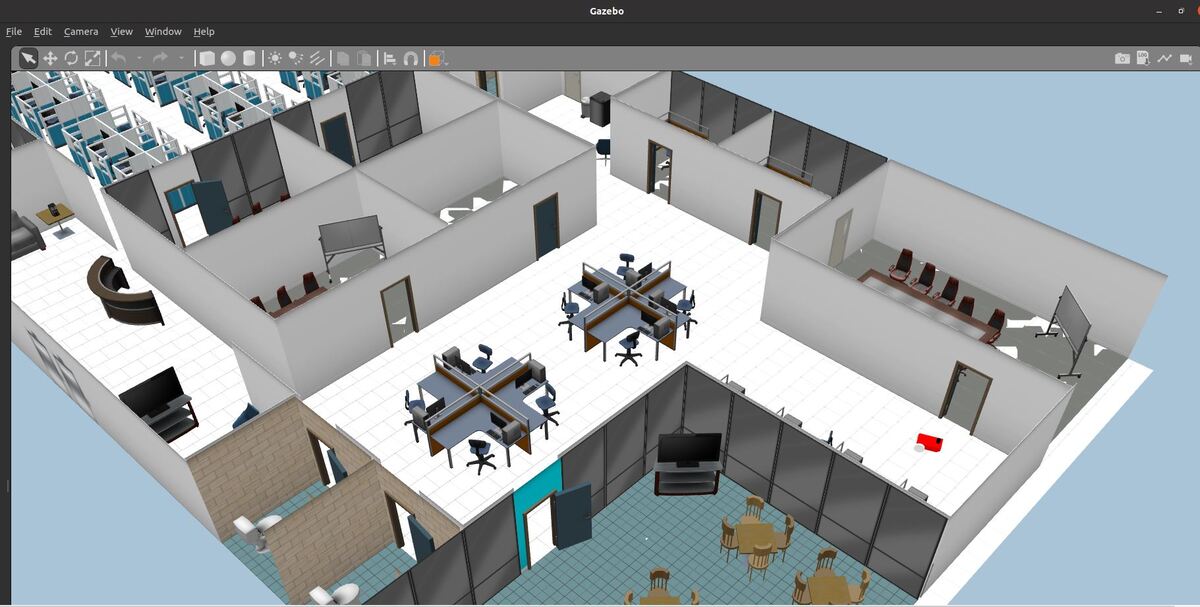In this tutorial, I will show you how to create an indoor delivery robot using the ROS 2 Navigation Stack (also known as Nav2) using Python code. Here is the final output you will be able to achieve after going through this tutorial:
Real-World Applications
The application that we will develop in this tutorial can be used in a number of real-world robotic applications:
- Hospitals and Medical Centers
- Hotels (e.g. Room Service)
- Offices
- Restaurants
- Warehouses
- And more…
We will focus on offices in this tutorial. You can see how the office world looks by going to this post.
Prerequisites
- ROS 2 Foxy Fitzroy installed on Ubuntu Linux 20.04 or newer. I am using ROS 2 Galactic, which is the latest version of ROS 2 as of the date of this post.
- You have already created a ROS 2 workspace. The name of our workspace is “dev_ws”, which stands for “development workspace.”
- You have Python 3.7 or higher.
- (Optional) You have completed my Ultimate Guide to the ROS 2 Navigation Stack.
- (Optional) You have a package named two_wheeled_robot inside your ~/dev_ws/src folder, which I set up in this post. If you have another package, that is fine.
- (Optional) You know how to load a world file into Gazebo using ROS 2.
You can find the files for this post here on my Google Drive. Credit to this GitHub repository for the Python scripts. You can find an explanation of Nav2 here.
Directions
Open a terminal window, and move to your package.
cd ~/dev_ws/src/two_wheeled_robot/scripts
Open a new Python program called pick_and_deliver.py.
gedit pick_and_deliver.py
Add this code.
#! /usr/bin/env python3
# Copyright 2021 Samsung Research America
#
# Licensed under the Apache License, Version 2.0 (the "License");
# you may not use this file except in compliance with the License.
# You may obtain a copy of the License at
#
# http://www.apache.org/licenses/LICENSE-2.0
#
# Unless required by applicable law or agreed to in writing, software
# distributed under the License is distributed on an "AS IS" BASIS,
# WITHOUT WARRANTIES OR CONDITIONS OF ANY KIND, either express or implied.
# See the License for the specific language governing permissions and
# limitations under the License.
#
# Modified by AutomaticAddison.com
import time # Time library
from copy import deepcopy # Modifying a deep copy does not impact the original
from geometry_msgs.msg import PoseStamped # Pose with ref frame and timestamp
from rclpy.duration import Duration # Handles time for ROS 2
import rclpy # Python client library for ROS 2
from robot_navigator import BasicNavigator, NavigationResult # Helper module
# Positions for picking up items
pick_positions = {
"front_reception_desk": [-2.5, 1.4],
"rear_reception_desk": [-0.36, 20.0],
"main_conference_room": [18.75, 15.3],
"main_break_room": [15.5, 5.4]}
# Positions for delivery of items
shipping_destinations = {
"front_reception_desk": [-2.5, 1.4],
"rear_reception_desk": [-0.36, 20.0],
"main_conference_room": [18.75, 15.3],
"main_break_room": [15.5, 5.4]}
'''
Pick up an item in one location and deliver it to another.
The assumption is that there is a person at the pick and delivery location
to load and unload the item from the robot.
'''
def main():
# Recieved virtual request for picking item at front_reception_desk and bring to
# employee at main_conference_room. This request would
# contain the pick position ("front_reception_desk") and shipping destination ("main_conference_room")
####################
request_item_location = 'front_reception_desk'
request_destination = 'main_conference_room'
####################
# Start the ROS 2 Python Client Library
rclpy.init()
# Launch the ROS 2 Navigation Stack
navigator = BasicNavigator()
# Set the robot's initial pose if necessary
# initial_pose = PoseStamped()
# initial_pose.header.frame_id = 'map'
# initial_pose.header.stamp = navigator.get_clock().now().to_msg()
# initial_pose.pose.position.x = 0.0
# initial_pose.pose.position.y = 1.0
# initial_pose.pose.position.z = 0.0
# initial_pose.pose.orientation.x = 0.0
# initial_pose.pose.orientation.y = 0.0
# initial_pose.pose.orientation.z = 0.0
# initial_pose.pose.orientation.w = 1.0
# navigator.setInitialPose(initial_pose)
# Wait for navigation to fully activate
navigator.waitUntilNav2Active()
# Set the pick location
pick_item_pose = PoseStamped()
pick_item_pose.header.frame_id = 'map'
pick_item_pose.header.stamp = navigator.get_clock().now().to_msg()
pick_item_pose.pose.position.x = pick_positions[request_item_location][0]
pick_item_pose.pose.position.y = pick_positions[request_item_location][1]
pick_item_pose.pose.position.z = 0.0
pick_item_pose.pose.orientation.x = 0.0
pick_item_pose.pose.orientation.y = 0.0
pick_item_pose.pose.orientation.z = 0.0
pick_item_pose.pose.orientation.w = 1.0
print('Received request for item picking at ' + request_item_location + '.')
navigator.goToPose(pick_item_pose)
# Do something during our route
# (e.g. queue up future tasks or detect person for fine-tuned positioning)
# Simply print information for employees on the robot's distance remaining
i = 0
while not navigator.isNavComplete():
i = i + 1
feedback = navigator.getFeedback()
if feedback and i % 5 == 0:
print('Distance remaining: ' + '{:.2f}'.format(
feedback.distance_remaining) + ' meters.')
result = navigator.getResult()
if result == NavigationResult.SUCCEEDED:
print('Got product from ' + request_item_location +
'! Bringing product to shipping destination (' + request_destination + ')...')
shipping_destination = PoseStamped()
shipping_destination.header.frame_id = 'map'
shipping_destination.header.stamp = navigator.get_clock().now().to_msg()
shipping_destination.pose.position.x = shipping_destinations[request_destination][0]
shipping_destination.pose.position.y = shipping_destinations[request_destination][1]
shipping_destination.pose.position.z = 0.0
shipping_destination.pose.orientation.x = 0.0
shipping_destination.pose.orientation.y = 0.0
shipping_destination.pose.orientation.z = 0.0
shipping_destination.pose.orientation.w = 1.0
navigator.goToPose(shipping_destination)
elif result == NavigationResult.CANCELED:
print('Task at ' + request_item_location + ' was canceled. Returning to staging point...')
initial_pose.header.stamp = navigator.get_clock().now().to_msg()
navigator.goToPose(initial_pose)
elif result == NavigationResult.FAILED:
print('Task at ' + request_item_location + ' failed!')
exit(-1)
while not navigator.isNavComplete():
pass
exit(0)
if __name__ == '__main__':
main()
The orientation values are in quaternion format. You can use this calculator to convert from Euler angles (e.g. x = 0 radians, y = 0 radians, z = 1.57 radians) to quaternion format (e.g. x = 0, y, = 0, z = 0.707, w = 0.707).
Save the code and close the file.
Change the access permissions on the file.
chmod +x pick_and_deliver.py
Open a new Python program called robot_navigator.py.
gedit robot_navigator.py
Add this code.
Save the code and close the file.
Change the access permissions on the file.
chmod +x robot_navigator.py
Open CMakeLists.txt.
cd ~/dev_ws/src/two_wheeled_robot
gedit CMakeLists.txt
Add the Python executables.
scripts/robot_navigator.py scripts/pick_and_deliver.py
Here is my full CMakeLists.txt file.
Add the launch file.
cd ~/dev_ws/src/two_wheeled_robot/launch/office_world
gedit office_world_v1.launch.py
Save and close.
Add the Nav2 parameters.
cd ~/dev_ws/src/two_wheeled_robot/params/office_world
gedit nav2_params.yaml
Save and close.
Now we build the package.
cd ~/dev_ws/
colcon build
Open a new terminal and launch the robot in a Gazebo world.
ros2 launch two_wheeled_robot office_world_v1.launch.py
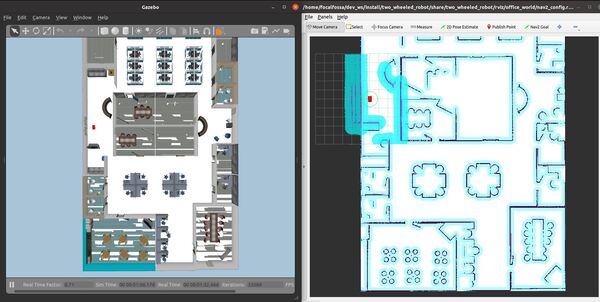
Now send the robot from the front desk to the main conference room by opening a new terminal window, and typing:
ros2 run two_wheeled_robot pick_and_deliver.py
The robot will go from the front desk to the main conference room.
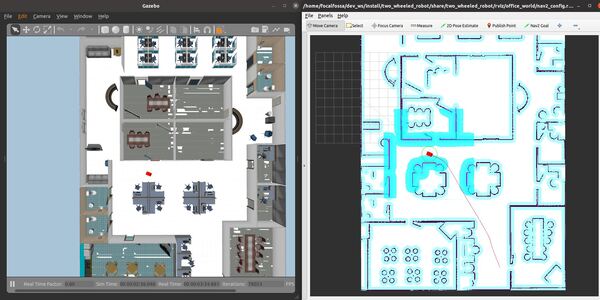
A success message will print once the robot has reached the conference room.

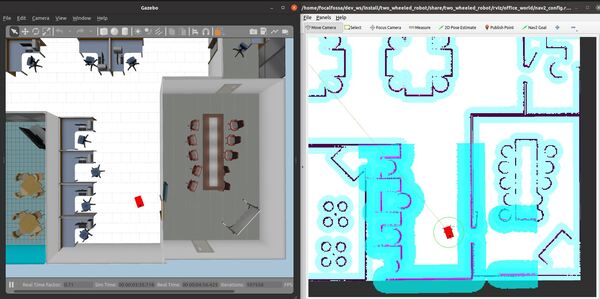
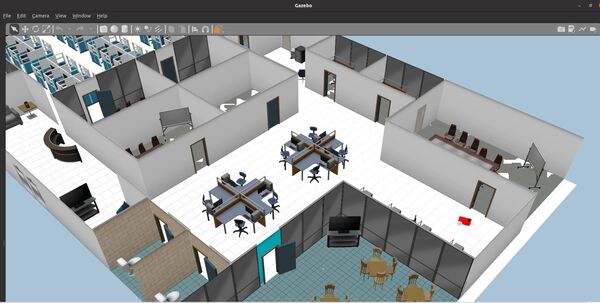
That’s it! Keep building!

